“It will allow farmers and distributors to make dramatic improvements in efficiency, putting downward pressure on prices.”
From Wall Street Journal.
“It will allow farmers and distributors to make dramatic improvements in efficiency, putting downward pressure on prices.”
From Wall Street Journal.
Blog Post | Energy & Natural Resources

The Simon Abundance Index (SAI) quantifies and measures the relationship between resources and population. The SAI converts the relative abundance of 50 basic commodities and the global population into a single value. The index started in 1980 with a base value of 100. In 2023, the SAI stood at 609.4, indicating that resources have become 509.4 percent more abundant over the past 43 years. All 50 commodities were more abundant in 2023 than in 1980.
Figure 1: The Simon Abundance Index: 1980–2023 (1980 = 100)

The SAI is based on the ideas of University of Maryland economist and Cato Institute senior fellow Julian Simon, who pioneered research on and analysis of the relationship between population growth and resource abundance. If resources are finite, Simon’s opponents argued, then an increase in population should lead to higher prices and scarcity. Yet Simon discovered through exhaustive research over many years that the opposite was true. As the global population increased, virtually all resources became more abundant. How is that possible?
Simon recognized that raw materials without the knowledge of how to use them have no economic value. It is knowledge that transforms raw materials into resources, and new knowledge is potentially limitless. Simon also understood that it is only human beings who discover and create knowledge. Therefore, resources can grow infinitely and indefinitely. In fact, human beings are the ultimate resource.
Visualizing the Change
Resource abundance can be measured at both the personal level and the population level. We can use a pizza analogy to understand how that works. Personal-level abundance measures the size of an individual pizza slice. Population-level abundance measures the size of the entire pizza pie. The pizza pie can get larger in two ways: the slices can get larger, or the number of slices can increase. Both can happen at the same time.
Growth in resource abundance can be illustrated by comparing two box charts. Create the first chart, representing the population on the horizontal axis and personal resource abundance on the vertical axis. Draw a yellow square to represent the start year of 1980. Index both population and personal resource abundance to a value of one. Then draw a second chart for the end year of 2023. Use blue to distinguish this second chart. Scale it horizontally for the growth in population and vertically for the growth in personal resource abundance from 1980. Finally, overlay the yellow start-year chart on the blue end-year chart to see the difference in resource abundance between 1980 and 2023.
Figure 2: Visualization of the Relationship between Global Population Growth and Personal Resource Abundance of the 50 Basic Commodities (1980–2023)

Between 1980 and 2023, the average time price of the 50 basic commodities fell by 70.4 percent. For the time required to earn the money to buy one unit of this commodity basket in 1980, you would get 3.38 units in 2023. Consequently, the height of the vertical personal resource abundance axis in the blue box has risen to 3.38. Moreover, during this 43-year period, the world’s population grew by 3.6 billion, from 4.4 billion to over 8 billion, indicating an 80.2 percent increase. As such, the width of the blue box on the horizontal axis has expanded to 1.802. The size of the blue box, therefore, has grown to 3.38 by 1.802, or 6.094 (see the middle box in Figure 2).
As the box on the right shows, personal resource abundance grew by 238 percent; the population grew by 80.2 percent. The yellow start box has a size of 1.0, while the blue end box has a size of 6.094. That represents a 509.4 percent increase in population-level resource abundance. Population-level resource abundance grew at a compound annual rate of 4.3 percent over this 43-year period. Also note that every 1-percentage-point increase in population corresponded to a 6.35-percentage-point increase in population-level resource abundance (509.4 ÷ 80.2 = 6.35).
Individual Commodity Changes: 1980–2023
As noted, the average time price of the 50 basic commodities fell by 70.4 percent between 1980 and 2023. As such, the 50 commodities became 238.1 percent more abundant (on average). Lamb grew most abundant (675.1 percent), while the abundance of coal grew the least (30.7 percent).
Figure 3: Individual Commodities, Percentage Change in Time Price and Percentage Change in Abundance: 1980–2023
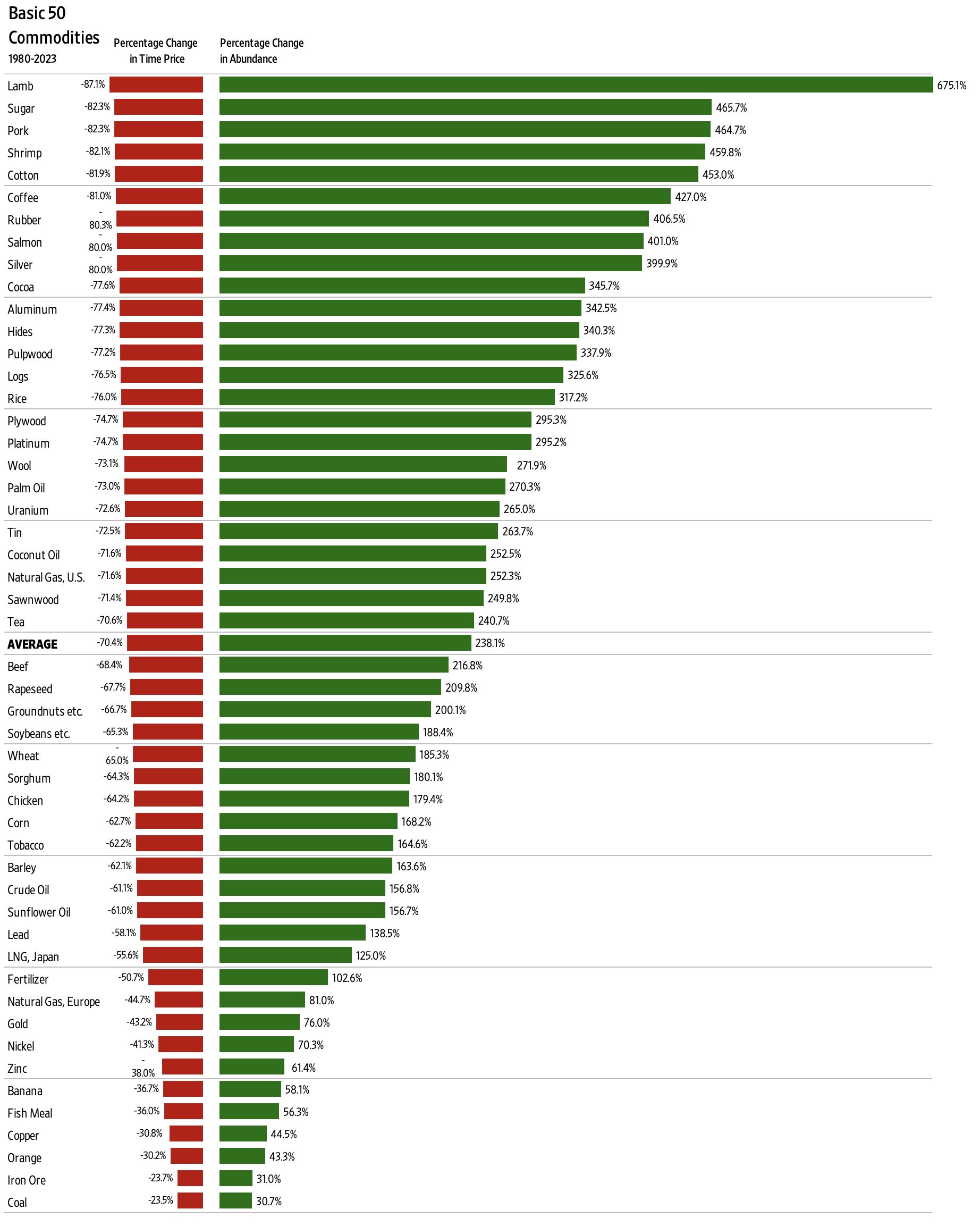
Individual Commodity Changes: 2022–2023
The SAI increased from a value of 520.1 in 2022 to 609.4 in 2023, indicating a 17.1 percent increase. Over those 12 months, 37 of the 50 commodities in the data set increased in abundance, while 13 decreased in abundance. Abundance ranged from a 220.8 percent increase for natural gas in Europe to a 38.9 percent decrease for oranges.
Figure 4: Individual Commodities, Percentage Change in Abundance: 2022–2023
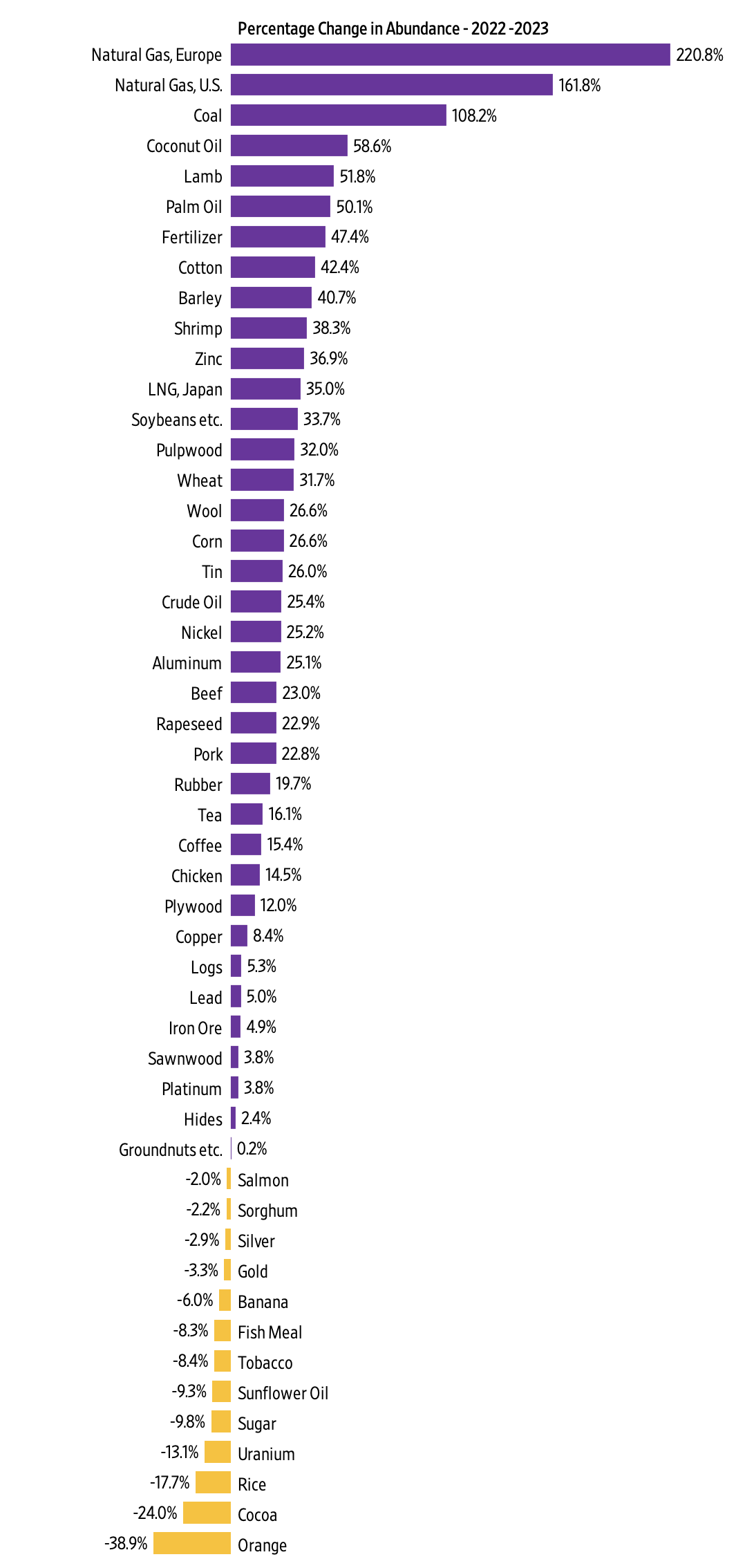
Conclusion
After a sharp downturn between 2021 and 2022, which was caused by the COVID-19 pandemic, government lockdowns and accompanying monetary expansion, and the Russian invasion of Ukraine, the SAI is making a strong recovery. As noted, since 1980 resource abundance has been increasing at a much faster rate than population. We call that relationship superabundance. We explore this topic in our book Superabundance: The Story of Population Growth, Innovation, and Human Flourishing on an Infinitely Bountiful Planet.
Appendix A: Alternative Figure 1 with a Regression Line, Equation, R-Square, and Population

Appendix B: The Basic 50 Commodities Analysis: 1980–2023
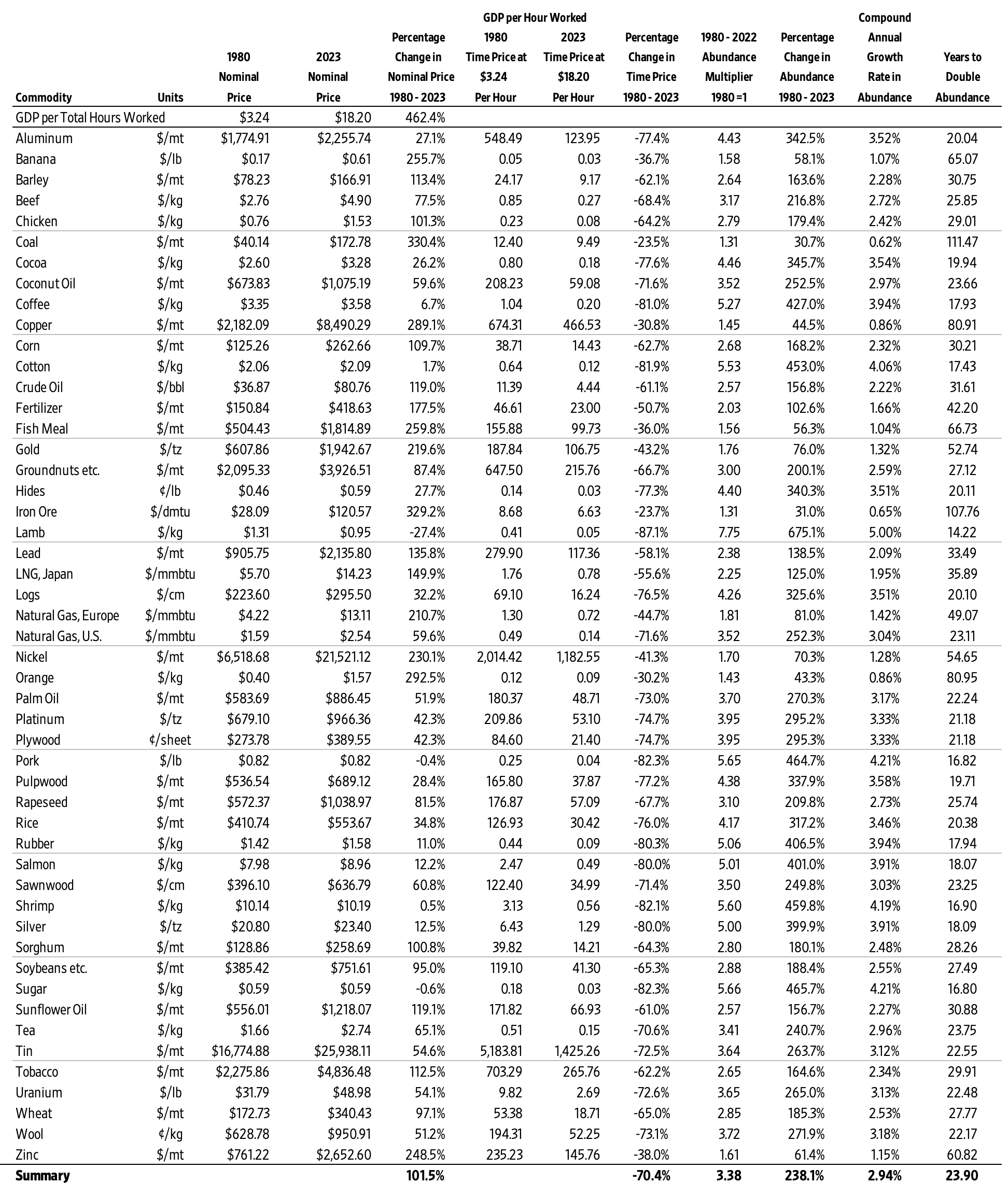
Appendix C: Why Time Is Better Than Money for Measuring Resource Abundance
To better understand changes in our standard of living, we must move from thinking in quantities to thinking in prices. While the quantities of a resource are important, economists think in prices. This is because prices contain more information than quantities. Prices indicate if a product is becoming more or less abundant.
But prices can be distorted by inflation. Economists attempt to adjust for inflation by converting a current or nominal price into a real or constant price. This process can be subjective and contentious, however. To overcome such problems, we use time prices. What is most important to consider is how much time it takes to earn the money to buy a product. A time price is simply the nominal money price divided by the nominal hourly income. Money prices are expressed in dollars and cents, while time prices are expressed in hours and minutes. There are six reasons time is a better way than money to measure prices.
First, time prices contain more information than money prices do. Since innovation lowers prices and increases wages, time prices more fully capture the benefits of valuable new knowledge and the growth in human capital. To just look at prices without also looking at wages tells only half the story. Time prices make it easier to see the whole picture.
Second, time prices transcend the complications associated with converting nominal prices to real prices. Time prices avoid subjective and disputed adjustments such as the Consumer Price Index (CPI), the GDP Deflator or Implicit Price Deflator (IPD), the Personal Consumption Expenditures price index (PCE), and the Purchasing Power Parity (PPP). Time prices use the nominal price and the nominal hourly income at each point in time, so inflation adjustments are not necessary.
Third, time prices can be calculated on any product with any currency at any time and in any place. This means you can compare the time price of bread in France in 1850 to the time price of bread in New York in 2023. Analysts are also free to select from a variety of hourly income rates to use as the denominator when calculating time prices.
Fourth, time is an objective and universal constant. As the American economist George Gilder has noted, the International System of Units (SI) has established seven key metrics, of which six are bounded in one way or another by the passage of time. As the only irreversible element in the universe, with directionality imparted by thermodynamic entropy, time is the ultimate frame of reference for almost all measured values.
Fifth, time cannot be inflated or counterfeited. It is both fixed and continuous.
Sixth, we have perfect equality of time with exactly 24 hours in a day. As such, we should be comparing time inequality, not income inequality. When we measure differences in time inequality instead of income inequality, we get an even more positive view of the global standards of living.
These six reasons make using time prices superior to using money prices for measuring resource abundance. Time prices are elegant, intuitive, and simple. They are the true prices we pay for the things we buy.
The World Bank and the International Monetary Fund (IMF) track and report nominal prices on a wide variety of basic commodities. Analysts can use any hourly wage rate series as the denominator to calculate the time price. For the SAI, we created a proxy for global hourly income by using data from the World Bank and the Conference Board to calculate nominal GDP per hour worked.
With this data, we calculated the time prices for all 50 of the basic commodities for each year and then compared the change in time prices over time. If time prices are decreasing, personal resource abundance is increasing. For example, if a resource’s time price decreases by 50 percent, then for the same amount of time you get twice as much, or 100 percent more. The abundance of that resource has doubled. Or, to use the pizza analogy, an individual slice is twice as large. If the population increases by 25 percent over the same period, there will be 25 percent more slices. The pizza pie will thus be 150 percent larger [(2.0 x 1.25) – 1].

Reading the news can leave you depressed and misinformed. It’s partisan, shallow, and, above all, hopelessly negative. As Steven Pinker from Harvard University quipped, “The news is a nonrandom sample of the worst events happening on the planet on a given day.”
So, why does Human Progress feature so many news items? And why did I compile them in this giant list? Here are a few reasons:
Below is a nonrandom sample (n = ~1000) of positive news we collected this year, separated by topic area. Please scroll, skim, and click. Or—to be even more enlightened—read this blog post and then look through our collection of long-term trends and datasets.
Blog Post | Cost of Material Goods

This article was originally published at Gale Winds on 12/9/2023.
In the 1990 movie Home Alone, eight-year-old Kevin McCallister went grocery shopping. He bought a half gallon of milk, a half-gallon of orange juice, a TV dinner, bread, frozen mac and cheese, laundry detergent, cling wrap, toilet paper, a pack of toy soldiers, and dryer sheets. His bill came to $19.83.
Professor Christopher Clarke at Washington State University did an analysis of the items and estimated that today’s price would be about $40.60, or 104.7 percent higher. But we know that things can become more expensive and more affordable at the same time. How is this possible?
Because wages typically increase faster than prices. In the past 33 years, unskilled hourly wages have increased by 178.3 percent from $6.03 per hour to around $16.50. This means the time price of Kevin’s basket has fallen by 25.2 percent. For the time it took to earn the money to buy the basket in 1990, you get 1.337 baskets today. Grocery abundance has increased by 33.7 percent.
If you had been upskilling from an unskilled labor job in 1990 to a blue-collar job today, your wages increased 505.8 percent from $6.03 to $36.50 an hour. Your time price fell by 66.2 percent, giving you almost three times more (195.6 percent) for your hour of work.

Don’t forget to count the kids before taking off on Christmas vacation this year, and remember, life can become more abundant every day if people are free to innovate.

Professor Jeremy Horpedahl has provided updated numbers on the percentage changes in four products essential to enjoying our Thanksgiving holiday. Remember, it’s not how expensive things are but how affordable they are that counts. To measure affordability, we must compare prices to wages. This is what time prices do for us. A time price is simply the nominal money price divided by nominal hourly income. Since last year, the nominal money prices of our four essential items have decreased from 0.8 percent to 13 percent, while nominal hourly income has increased by 4.4 percent. That means that personal abundance has increased by between 5.2 percent and 20 percent.
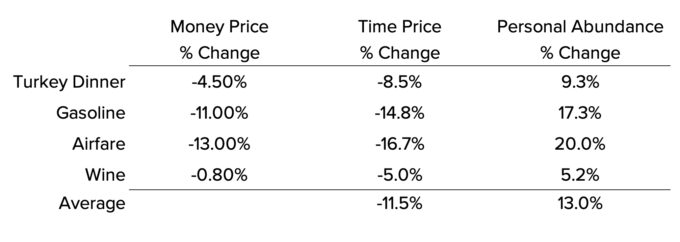
Dividing the percentage change in the nominal money prices by the percentage change in nominal wages reveals the percentage change in the time price. Personal abundance is how much more you now enjoy for the same amount of time relative to last year. We get 13 percent more Thanksgiving this year for the same amount of time it took last year.
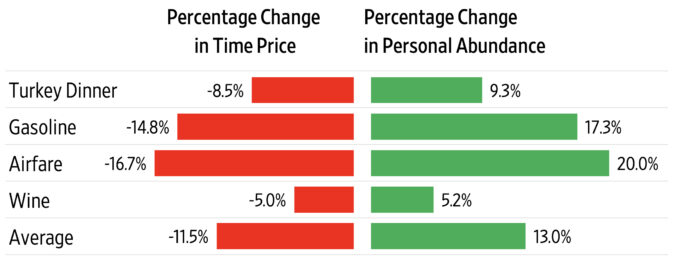
Sources: “Cost of Thanksgiving Dinner Down Slightly from Record High in 2022,” news release, American Farm Bureau Federation, November 15, 2023; U.S. Energy Information Administration, “US Regular All Formulations Gas Price,” FRED Economic Data, Federal Reserve Bank of St. Louis, updated November 13, 2023; Bureau of Labor Statistics, “Consumer Price Index for All Urban Consumers: Airline Fares in US City Average,” FRED Economic Data, Federal Reserve Bank of St. Louis, updated November 14, 2023; Bureau of Labor Statistics, “Average Price: Wine, Red and White Table, All Sizes, Any Origin (Cost per 1 Liter/33.8 Ounces) in US City Average,” FRED Economic Data, Federal Reserve Bank of St. Louis, updated November 14, 2023; and Bureau of Labor Statistics, “Average Hourly Earnings of Production and Nonsupervisory Employees, Total Private,” FRED Economic Data, Federal Reserve Bank of St. Louis, updated November 3, 2023.
We describe the process of transforming scarcities into abundances in our book, Superabundance, available at Amazon. Jordan Peterson calls it a “profoundly optimistic book.” There has never been a better time to create more life.